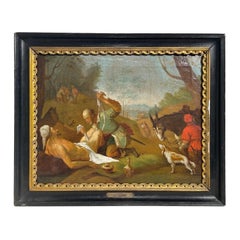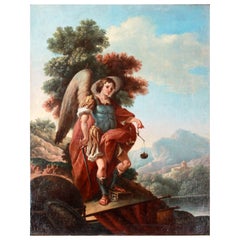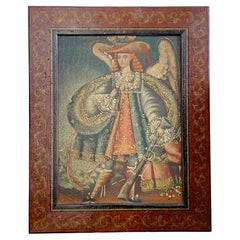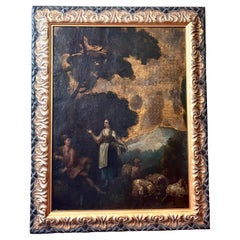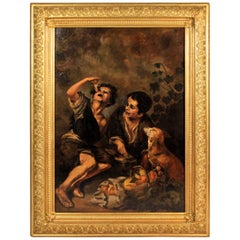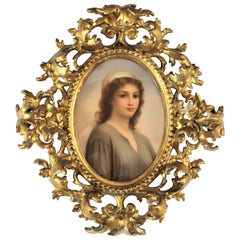Austrian Paintings
1
3
to
1
2
1
3
3
3
18
14
9
8
3
2
2
2
1
1
1
2
1
Height
to
Width
to
2
2
2
1
13,189
347
161
48
33
1
Style: Baroque
Place of Origin: Austrian
18th Century Austrian Baroque Oil on Canvas Painting by Franz Xaver Hornöck
By Franz Xaver Hornöck
Located in West Palm Beach, FL
A light-brown, green antique Austrian Baroque oil on canvas painting by Franz Xaver Hornöck in a hand crafted original black, partly gilded wooden frame, in good condition. The vinta...
Category
18th Century Baroque Antique Austrian Paintings
Materials
Canvas, Wood
Michelangelo Unterperger 'Circle' ca. 1775 "St. Michael Archangel" (71x88x7cm)
Located in Firenze, FI
Stunning late 1700s baroque oil painting (Fiemme Valley. Trentino) Strongly considered a Unterperger's circle artwork by the experts hired for this task...
Category
1770s Baroque Antique Austrian Paintings
Materials
Canvas, Paint
Hans Ruzicka Lautenschlaeger Oil on Canvas, 19/20th Century
By Flemish
Located in Madrid, ES
Hans Ruzicka Lautenschlaeger
19/20th century
Oil on canvas.
52 x 41 cm unframed.
Good condition.
Category
Early 19th Century Baroque Antique Austrian Paintings
Materials
Paint
Related Items
19th Century Cuzco School Oil On Canvas Archangel Michael
Located in Hastings, GB
Peruvian Cuzo School Oil on Canvas of the Archangel Michael. Canvas has been remounted on new stretchers, a few small marks to the edge of the frame.
The Cuzco or Cusco school was...
Category
Early 19th Century Rococo Antique Austrian Paintings
Materials
Canvas, Paint
18th Century French Baroque Old Master Painting Oil on Leather
Located in Vero Beach, FL
18th century French Baroque Old Master painting oil on leather.
Old Master painting, French Baroque period 18th century oil on leather represents a lush imaginary landscape in ric...
Category
18th Century Baroque Antique Austrian Paintings
Materials
Leather
19th Century Cuzco School Oil Painting of Archangel Raphael
Located in NICE, FR
We present you with this oil-on-canvas painting from the 19th century representing Archangel Raphael who is said to guard pilgrims on their journeys and is often depicted holding a s...
Category
19th Century Spanish Colonial Antique Austrian Paintings
Materials
Canvas
Pair of 18 Century Paintings of St Francis Xavier and St Carlo Borromeo
Located in Vancouver, British Columbia
A beautifully executed and rare complementary pair of oil on canvas paintings depicting two of the moist famous and important counter reformation catholic saints St Francis Xavier and St Carlo Borromeo shown in scenes of what the respective saints are mostly famous for. St Francis Xavier for the conversion to Christianity of many S. E Asian countries notably India and St Carlo Borromeo shown asking the Virgin Mary to intercede for the cessation of the terrible plague of 1576. The paintings are presented in refreshed gilded carved wooden frames and are unsigned.
St. Francis Xavier was born in Spanish Navarre in 1506 and in 1528, he met St. Ignatius of Loyola. He became one of the seven in 1534 who founded the Society of Jesus (Jesuit Order). In 1536, he left the University of Paris and joined St. Ignatius in Venice. He was ordained in 1537, and in 1540 after the Society was recognized by the Pope, he journeyed to the Far East. Francis Xavier first evangelized the Portuguese colony of Goa in India, then Travancore, Ceylon, Malacca, and the surrounding islands. From there he journeyed to Japan, where he gave Christianity such deep roots that it survived centuries of violent persecution. He died on Sancian Island in 1552, while he was seeking to penetrate into the great forbidden land of China.
Despite language problems, lack of funds, resistance from the Europeans as well as the natives, he persevered. St. Francis converted more people in his life than anyone since the Apostle St. Paul. He baptized over 3 million people, converted the entire town of Goa in India, and he labored in India, Pakistan, Bangladesh, Sri Lanka, Malaysia, Indonesia, Singapore, and Japan. He was truly a missionary par excellence.
St Carlo Borromeo (1538-1584), was a Cardinal of the Holy Roman Catholic Church and Archbishop of Milan from 1565 to 1583. He was described in the decree for his canonization, as “a man, even while the world smiles on him with the utmost flattery, he lives crucified to the world, spiritually, trampling earthly things, seeking continuously the things of heaven, emulating the life of the Angels on earth, in his thoughts and actions.
The plague began in the month of August that year. Milan was celebrating joyfully the arrival of Don John of Austria, on his way to Flanders, where he had been appointed governor. The city authorities were abuzz with excitement in their desire to bestow the highest honours on the Spanish prince, but Charles, who had been Archbishop of the diocese for six years, was following with concern the news coming from Trento, Verona and Mantua, where the plague had begun claiming victims. The first cases exploded in Milan on August 11th, right at the moment when Don John of Austria arrived. The victor of Lepanto, followed by the governor, Antonio de Guzmán y Zuñiga, departed the city, while Carlo Borromeo, who was in Lodi for the Bishop’s funeral, returned in haste.
Confusion and fear reigned in Milan and the Archbishop dedicated himself completely to assisting the sick and ordering public and private prayers. Dom Prosper Guéranger sums up his infinite charity in this way: “In the absence of local authorities, he organized the health service, founded or renewed hospitals, sought money and provisions, decreed preventive measures. Most importantly though, he took steps to ensure spiritual help, assistance to the sick and the burial of the dead. Unafraid of being infected, he paid in person, by visiting hospitals, leading penitential processions, being everything to everyone, like a father and true shepherd”
St. Carlo was convinced that the epidemic was “a scourge sent by Heaven” as chastisement for the sins of the people and that recourse to spiritual measures was necessary to fight against it: prayer and penitence. He rebuked the civil authorities for having placed their trust in human measures rather than divine ones. “Hadn’t they prohibited all the pious gatherings and processions during the time of the Jubilee? For him, and he was convinced of it, these were the causes of the chastisement. The magistrates who governed the city continued to oppose public ceremonies, out of fear that the large gathering of people would spread contagion, but Charles “who was guided by the Divine Spirit” – recounts another biographer – convinced them by citing various examples, among which was the one regarding St. Gregory the Great who had halted the plague devastating Rome in 590.
While the pestilence spread, the Archbishop then ordered three general processions to take place in Milan on the 3rd, 5th and 6th of October, “to placate the wrath of God”. On the first day, the Saint, despite it not being the Lenten season, placed ashes on the heads of the thousands gathered, exhorting them to penitence. Once the ceremony was over, the procession went to the Basilica of St. Ambrose. Charles put himself at the head of the people, dressed in a hooded purple robe, barefoot, penitential cord at his neck and large cross in his hand.
The second procession led by the Cardinal headed towards the Basilica of San Lorenzo. The third day the procession from the Duomo headed for the Basilica of Santa Maria at San Celso. St. Carlo carried in his hands a relique of Our Lord’s Holy Nail, which had been given by the Emperor Theodosius to St. Ambrose in the 5th century.
The plague didn’t show any signs of waning and Milan appeared depopulated, as a third of its citizens had lost their lives and the others were in quarantine or didn’t dare leave their homes. The Archbishop ordered about twenty stone columns with a cross at the top to be erected in the main squares and city crossroads, allowing the inhabitants from every quarter to take part in the Masses and public prayers - from the windows of their homes. One of Milan’s protectors was St. Sebastian, the martyr the Romans had recourse to during the plague in 672. St. Charles suggested that the magistrates of Milan reconstruct the sanctuary dedicated to him, which was falling into ruins, and to celebrate a solemn feast in his honour for ten years. Finally in July 1577, the plague ceased and in September the founding stone was laid in the civic temple of St. Sebastian, where on January 20th every year, even today a Mass is offered to recall the end of the scourge.
St.Carlo Borromeo died on November 3rd 1584 and was buried in the Duomo of Milan. His heart was solemnly translated to Rome, in the Basilica of Saints Ambrose...
Category
Late 18th Century Baroque Antique Austrian Paintings
Materials
Canvas
California Oil on Canvas Painting, 19th Century
Located in Cypress, CA
California oil on canvas landscape painting, "Evening Glow" - Otto Robert Gaensslen (1876-1915; American)
Late 19th-early 20th century.
Artist Bio: ...
Category
Late 19th Century Antique Austrian Paintings
Materials
Canvas
Cuzco School Oil Painting of Archangel Michael, 19th Century
Located in NICE, FR
We present you with this oil-on-canvas painting from the 19th century representing Archangel Michael - the chief of the angels and archangels.
The painting follows the style of the...
Category
19th Century Spanish Colonial Antique Austrian Paintings
Materials
Canvas
French 18th-19th Century Oil on Canvas Portrait of Lady, after Jean-Marc Nattier
By Jean-Marc Nattier
Located in Los Angeles, CA
A very fine French 18th-19th century oil on canvas portrait of a posing lady with flowers, after Jean-Marc Nattier (1685-1766) within an ornate gilt wood carved frame, circa 1800.
...
Category
Early 19th Century Louis XV Antique Austrian Paintings
Materials
Canvas, Giltwood
H 58.63 in W 46.38 in D 4 in
19th Century Spanish Panel With Painting of Saint Michael The Archangel
Located in Houston, TX
This is an old Spanish hand painted panel that's from a church alter. It's got nice colors and missing just a few spots. I have shown several closeups to see the quality. It's depicting Saint Michael...
Category
19th Century Antique Austrian Paintings
Materials
Wood
Italian 18th Century Oil on Canvas "Madonna and Child" after Giovanni Lanfranco
By Giovanni Lanfranco
Located in Los Angeles, CA
A very fine Italian 18th century oil on canvas "Madonna and Child" after Giovanni Lanfranco (Italian, 1582-1647). The young Virgin Mary attending to...
Category
18th Century Baroque Antique Austrian Paintings
Materials
Canvas, Giltwood
H 44.25 in W 51.38 in D 3 in
ITALIAN SCHOOL "TOBIAS AND THE ARCHANGEL RAFAEL" 18th Century
By Europa Antiques
Located in Madrid, ES
ITALIAN SCHOOL "TOBIAS AND THE ARCHANGEL RAFAEL" 18TH CENTURY
Oil on canvas made in the 18th century,
It represents the moment in which the archangel Raphael instructs a young Tobit...
Category
Early 18th Century Baroque Antique Austrian Paintings
Materials
Paint
18th Century French Baroque Oil Painting
Located in Winter Park, FL
A late 18th century French painting depicting a romantic couple in a pastoral setting. Oil on canvas. Unsigned. Original gilded wood frame. Small repair to canvas in the upper left c...
Category
Late 18th Century Baroque Antique Austrian Paintings
Materials
Canvas, Giltwood, Paint
Early 20th Century Italian Oil Painting on Canvas
Located in Casale Monferrato, IT
Important early 20th century italian oil painting on canvas not signed. Woodland landscape. Painting of great artistic quality of impressionist taste.
Category
1920s Vintage Austrian Paintings
Materials
Canvas
Previously Available Items
Bartolome Esteban Murillo's "Kuchenesser" Oil on Canvas Reproduction, circa 1890
By Bartolomé Esteban Murillo
Located in Lichtenberg, AT
Masterful reproduction of the very famous painting "Kuchenesser" (translated: cake eaters) from the renown Spanish baroque painter Bartolome Esteban Perez Murillo (1618-1682). Superb...
Category
Late 19th Century Baroque Antique Austrian Paintings
Materials
Canvas, Wood
H 48.4 in W 36.6 in D 2.3 in
Antique Austrian Hand Painted Porcelain Portrait of 'Ruth' in Ornate Wood Frame
Located in Hamilton, Ontario
This antique hand painted porcelain medallion of the Biblical 'Ruth' is unsigned but presumed to have been done in Austria in approximately 1880 in the Royal Vienna style. The hand p...
Category
Late 19th Century Baroque Antique Austrian Paintings
Materials
Porcelain, Wood
H 12 in W 10.5 in D 2.5 in
18th Century Baroque Portrait of a Noble Lady
Located in Berlin, DE
18th Century Baroque Portrait of a Noble Lady
Oil on canvas. Recently restored.
Measures in cm:
without frame
Height 77 cm
Width 65 cm
(S-96).
Category
18th Century Baroque Antique Austrian Paintings
Materials
Canvas
Pastoral Idyll, Oil on Canvas, Attributed to Joseph Roos
Located in Lichtenberg, AT
Austrian J. Roos, great-grandson of famous German painter Johann Heinrich Roos (1631 – 1685) was known for southern landscapes bathed in gentle sunshine and featuring realistic views...
Category
Late 18th Century Baroque Antique Austrian Paintings
Materials
Giltwood
Landscape with Sheperd Family - attributed to Joseph Roos, 1726 - 1805
By Joseph Roos
Located in Lichtenberg, AT
Austrian painter J. Roos was the great-grandson of Johann Heinrich Roos, one of the most important German animal painter of the 17th century. Known for realistic portrayal of animals...
Category
Mid-18th Century Baroque Antique Austrian Paintings
Materials
Canvas, Giltwood
Recently Viewed
View AllMore Ways To Browse
Fluted Glass Cabinet
Antique Mahogany Bureau Writing Desk
Anglo Indian Cabinet
Pair Of Inlay Chests
Narrow Chest Of Drawers
Hall Cabinet Oak
Tallboy Chest
Solid Teak Chest
Pair Of American Chests
Large Painted Blue Cabinets
Pair Small Walnut Cabinets
Walnut Marble Shelf
Antique Mahogany Writing Bureau Desk
Antique Mahogany Writing Desk Bureau
Faux Marble Painted Chests
Mid Century Modern Large Commode
Antique Chinese Small Cabinet
Narrow Depth Storage
